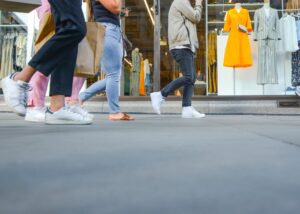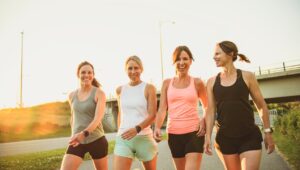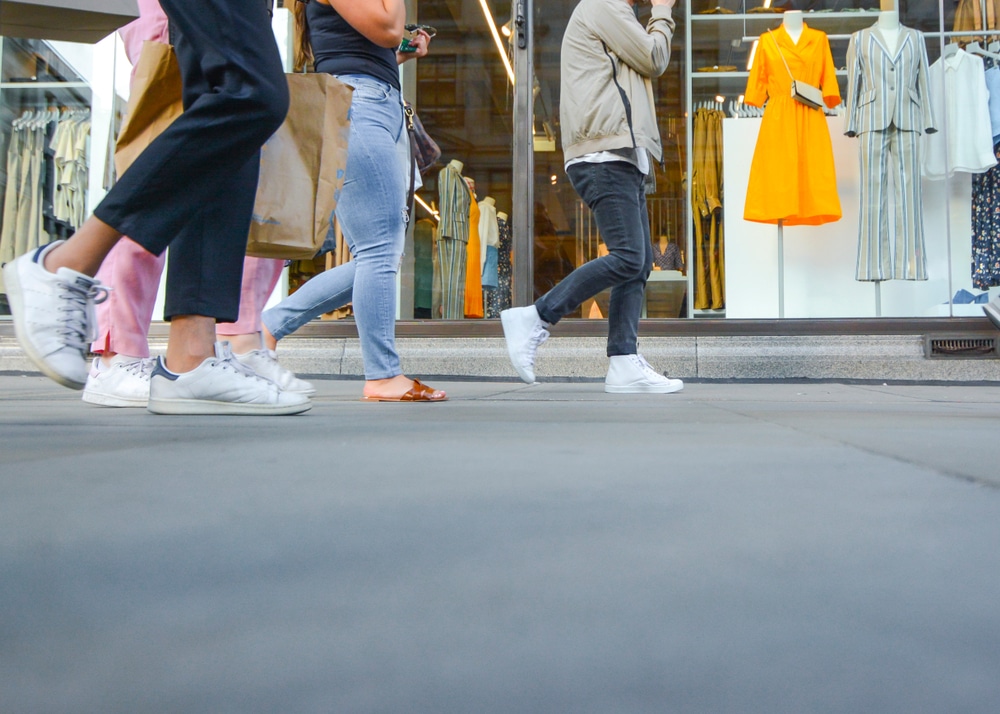With the convenience that online shopping has provided for consumers, many retailers are left wondering if they should be expending more effort to increase foot traffic in the coming years. Retail foot traffic declined by 1.7% on Black Friday, and 1% from 2017-2018 overall. This decline caused many retailers to close locations, specifically in malls. Approximately 8,000 store closures were announced in 2017 and continued into 2018 as Payless filed for bankruptcy, closing over 2,000 stores, followed by hundreds of closures from other major retailers like Charlotte Russe, Gap, Gymboree, and Victoria’s Secret.
While this may sound like bad news, retail sales across all channels actually increased 4%, hitting $3.628 trillion during that same time period. Despite the fact that online and mobile eCommerce sales continue to trend upward, almost 90% of retail dollars are spent in physical locations. Last year, holiday shoppers spent twice as much in brick-and-mortar retailers like Target and Walmart as they spent on Amazon, the world’s largest online marketplace. It’s apparent that retailers should be considering ways to increase foot traffic to capitalize on the number of consumers who still choose to shop in-store.
10 Tactics Retailers Are Using to Increase Foot Traffic
There are many strategies retailers can use to increase foot traffic that also have the potential to increase sales.
- Local Inventory Ads: One of the deterrents for in-store shopping is the perception that a particular location won’t carry the items for which a consumer is looking, or that the consumer will be unable to locate the item once inside the store. According to Google research, 80% of consumers will visit a physical store if they know the desired product will be in-stock. One of the most successful strategies retailers use is showing what’s in stock at a nearby store, and increasing Google advertising bids around those retail locations. When a shopper clicks on a local inventory ad, they are redirected to the retailer’s Google-hosted page or local storefront to browse the inventory in stock, view the store hours, or find a location. Sears saw a 122% increase in foot traffic and earned 8:1 ROI for its local inventory ad campaign.
- Location-Based Marketing: The number of mobile searches for “where to shop” and “where to buy” increased 85% from 2015-2017, revealing the urgent desire for shoppers to find the items they need close to their current physical locations. GPS, Wi-Fi, beacons, carrier data, IP addresses, and mobile apps can all be used to reach shoppers on the path to purchase. Most commonly, retailers encourage shoppers to opt-in to receive alerts and notifications about sales or special offers when near.
- Buy Online Pickup In-Store (BOPIS): Retailers have found creative ways to marry their online and in-store channels. Sometimes called “click and collect,” the basic premise is to offer shoppers greater convenience by combining the ease of buying a product online with the immediacy and tangibility of picking up in-store. Shoppers overcome the hassles of being unable to find the products they need down the aisles, waiting in lines, paying for shipping, or having to wait to receive their orders. The benefit for retailers is that 69% of BOPIS shoppers make additional purchases when picking up their original orders, with 49% of those items being unintended impulse buys.
- In-Store Returns of Online Orders: One of the impediments to buying online is having to print out return labels and visit a post office, UPS, or Fed-Ex drop-off location to return an item. Much like BOPIS, retailers like Walmart and Kohl’s have gone the extra mile to make it easier for shoppers to return items purchased online. Through a mobile app, Walmart customers can seamlessly return items in-store. Kohl’s accepts items purchased at Kohls.com and also any item purchased from Amazon.com. Getting shoppers in their stores has paid dividends. In one geolocation analysis of Chicago Kohl’s shoppers, there was an 8.5% spike in foot traffic following their pilot program with Amazon. Of those returning items, 56% were new shoppers or people who hadn’t been to the store in months. The pilot program yielded 8% year-over-year revenue growth, compared to the more modest national growth of 1-2% in the rest of their U.S. stores.
- Loyalty Programs with In-Store Savings: Loyalty programs are a great way to track individual customer purchases, create shopper personas, and personalize your marketing strategy. By partnering with a third-party shopping app like Shopkick, brands and retailers have the opportunity to reach more diverse audiences. Loyalty program apps also encourage in-store engagement, which helps to increase foot traffic and drive sales. With Shopkick, consumers can earn rewards points by simply scanning the barcodes of specific products with their phone, but also for purchasing these products and uploading their receipt. The incentive motivates shoppers to seek out products at-shelf and interact with them, which in turn increases sales and helps build positive brand affinity.
- Retargeting Campaigns: Existing customers are five times more likely to make a purchase than new prospects. It makes sense, then, to invest in efforts to retain customers. Re-engagement messages have been proven to be an effective tactic. Retailers should consider sending an email, letting shoppers know they’re missed and throw in a promotion to sweeten the deal. Send automated messages based on the length of time since the customer’s last purchase, making it easy for shoppers to re-stock. Remind online perusers of unpurchased items in their shopping carts, offering to help them overcome obstacles like costly shipping or price. Better yet, include information regarding the nearest store in case a shopper happens to want the item immediately.
- Storefront Advertising: Brick-and-mortar retailers have a unique advantage over their online counterparts in that they have a physical space to maximize. It’s hard to create a particular atmosphere that is conducive to selling online. It’s more about paring down the extravagance of the website to design the quickest possible path-to-purchase. With a storefront, the opposite is true; you want to create an environment that tantalizes the mind and draws shoppers in. For instance, during the height of popularity for the HBO series Game of Thrones, jewelry brand Alex and Ani created a line of charms based on the show and heavily promoted the new line with eye-catching promotional signage. Similarly, a number of retailers decorate their storefronts during holidays like Halloween or Christmas to entice impulse shoppers who want to stop in and see what’s new for the season.
 Experiential Marketing: The most innovative retailers are going above and beyond selling, creating unique, crowd-drawing events and spectacles that show brick-and-mortar stores are far from a dying breed. Physical products are your bread and butter, but today’s shopper craves an experience. Sell the feeling, the sense of community, and the event, and the repeat sales will inevitably follow. Some retailers serve food and drinks to make their locations more appealing. Others host parties, exclusive events, and demos. Some add complementary services like jewelry cleaning, spa treatments, or dry cleaning. Experiential marketing is one of the rising trends in retail that holds great power and promise to ramp up foot traffic in a dynamic way. One study found 70% of visitors became regular customers after attending an experiential event.
Experiential Marketing: The most innovative retailers are going above and beyond selling, creating unique, crowd-drawing events and spectacles that show brick-and-mortar stores are far from a dying breed. Physical products are your bread and butter, but today’s shopper craves an experience. Sell the feeling, the sense of community, and the event, and the repeat sales will inevitably follow. Some retailers serve food and drinks to make their locations more appealing. Others host parties, exclusive events, and demos. Some add complementary services like jewelry cleaning, spa treatments, or dry cleaning. Experiential marketing is one of the rising trends in retail that holds great power and promise to ramp up foot traffic in a dynamic way. One study found 70% of visitors became regular customers after attending an experiential event. - Social Sharing: Social networks remain one of the most influential purchase drivers, according to research from PwC, with 37% of consumers saying they use social media for purchase inspiration. Retailers can create social sharing opportunities within their stores to get people talking about their brands online. Displaying hashtags and social media handles in-store is essential. Aim to create the sort of decorative nooks and places with catchy slogans that inspire selfies.
- Omnichannel Shopping: More than 70% of shoppers use multiple channels to buy, compared to 7% exclusive online shoppers and 20% exclusive brick-and-mortar shoppers. More importantly, retailers with omnichannel shopping experiences retain 89% of their customers from channel to channel; by comparison, businesses focusing their efforts on a single channel see a 33% customer retention rate. There are limitless ways to unite different channels like retail stores, mobile, PC, and social for a more cohesive buyer’s journey. At a minimum, you’ll want to optimize a mobile version of your website, allow people to check store inventory online, pick up in-store, ship to store for free, and let customers choose how they want to receive offers and updates.
Increase Foot Traffic by Partnering With Shopkick
Shopkick provides retailers the perfect opportunity to increase foot traffic that ultimately leads to an increase in sales. When Sopkick’s retail partners wanted to measure the incrementality of the program, Visa Decision Sciences analyzed the sales, transactions, and customers that Shopkick was driving, and determined how many would not have occurred without Shopkick.
The findings were that Shopkick is a highly incremental program for retail partners as a whole and these results stand true across different retail verticals.
- 57% of all sales driven by Shopkick were incremental. That incremental spend was driven by new customer acquisition as well as increased loyalty of existing customers.
- 55% of department store sales were incremental, 49% of electronics/big box store sales were incremental and 67% of specialty store sales driven by Shopkick were incremental.
For retailers, it’s not just about getting shoppers into the store; it’s about getting them to specific sections of the store where the greatest sales potential exists, and converting purchases.
For retailers, it’s not just about getting shoppers into the store; it’s about getting them to specific sections of the store where the greatest sales potential exists, and converting purchases. Shopkick essentially works as a treasure map, driving shoppers to test out and try desired products, increasing engagement and purchase intent.
At Shopkick, we believe in creative retail strategies to increase foot traffic and drive engagement. That’s why our partners find such success when incorporating our innovative shopping app into their marketing strategy. Contact us to start using Shopkick to help increase foot traffic in your retail store.
Image courtesy of Willie Barton





